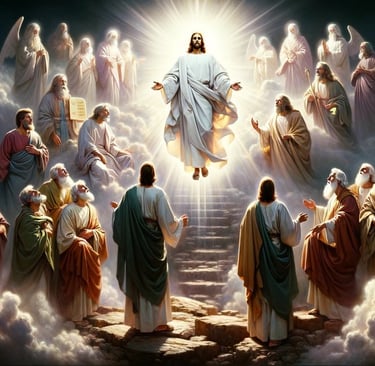The Transfiguration of the Lord Homily
As we gather today, I invite you to engage with a profound moment captured in the Gospel according to Luke, specifically Luke 9:28b-36. This passage describes the Transfiguration of our Lord. It is a scene of glory, divine revelation, and profound transformation.
HOMILIES


Homily on the Transfiguration of Jesus
Luke 9:28b-36
Dear brothers and sisters in Christ,
As we gather today, I invite you to engage with a profound moment captured in the Gospel according to Luke, specifically Luke 9:28b-36. This passage describes the Transfiguration of our Lord. It is a scene of glory, divine revelation, and profound transformation. As we unpack this scripture, we will explore the nature of divinity, the importance of faith, and the hope that lies in the glory of eternal life. We will also reflect on how this transformative experience can inspire our daily lives.
The Scene of Transfiguration
Let us immerse ourselves in this pivotal moment. Jesus takes Peter, James, and John up a high mountain to pray. As they ascend, fatigue may weigh upon them, but the anticipation of being in the presence of the Lord is palpable. Suddenly, as Jesus begins to pray, an astonishing transformation occurs. “The appearance of his face changed, and his clothes became dazzling white.” (Luke 9:29)
Now, dear friends, put yourself in the disciples’ shoes. How overwhelming it must have been to witness such a display. Imagine standing in the cold, crisp air of the mountain, and, without warning, the radiant beauty of Jesus envelops you. Would we feel confusion? Fear? Awe? Perhaps all of these at once! The divine glory of Christ breaks through the mundane, shaking the very foundations of their understanding.
The Nature of Divinity
Through this glorious display, we catch a glimpse of the divine nature of Christ. Here, on that mountain, divinity is laid bare before the disciples. This moment reveals not only who Jesus is—truly God and truly man—but also emphasises the union of His divine and human natures. The dazzling white of His clothes signifies purity, holiness, and the overwhelming reality of God’s presence.
In encountering this revelation of divinity, we recognise that God is not just an abstract concept but a person with whom we can have a relationship. Our faith is rooted in knowing this Jesus who reveals God's love for humanity. His transfiguration is a reminder that through Jesus, we, too, are called to encounter the divine and be transformed.
The Importance of Faith
As Peter, James, and John gaze upon the transfigured Christ, they are also confronted with their own humanity. After seeing this divine reality, Peter instinctively suggests making three tents to commemorate the moment. Yet, his misunderstanding highlights a key aspect of faith. Peter wants to hold onto this experience, freeze it in time, but faith calls us to recognise that such moments are not meant to be captured but lived out and carried forward.
Jesus understands our need for tangible experiences of grace. We all long for moments of divine intimacy, and though we want to hold onto them, true faith requires us to accept that the journey includes both moments of enlightenment and times of trial. This passage reminds us that faith is not merely about understanding but about trust.
When we are faced with the challenges of life—loss, suffering, doubt—how do we respond? Do we cling to our fears, or do we lean into faith? We must remember that our faith does not shield us from suffering; rather, it empowers us to face it with the knowledge that God walks with us.
The Glory After Death
The presence of Moses and Elijah during the transfiguration signifies prophetic fulfillments and continuity in God’s plan. Their appearance suggests a profound truth: that glory exists beyond the veil of earthly life. This is a prelude to the resurrection, affirming that death does not have the final say; eternal life awaits those who believe in Christ.
This message is essential as we navigate a world filled with despair and hopelessness. The promise of glory after death is our anchor, reminding us that our suffering has purpose and that the trials of this lifetime are but a shadow compared to the eternity that awaits us in God’s presence.
St. Paul writes in his letter to the Romans, “For I consider that the sufferings of this present time are not worth comparing with the glory about to be revealed to us.” (Romans 8:18). Our struggles can be sanctified through our faith, guiding us toward the glory that is promised to us in Christ.
The Disciples’ Perspective
As we have discussed, the disciples likely felt overwhelmed, confused, and terrified as they beheld the transfigured Christ. Their experience can evoke a sense of solidarity within us. How often do we find ourselves on the mountaintops of life, eager to hold onto the glory, only to be brought face to face with our difficulties when we descend? In those moments, we can recall their experience as they grappled with the divine reality laid before them.
Imagine walking down that mountain, still ringing with the memory of Christ’s radiance. Would there be a renewed sense of purpose? An unshakeable faith? Or perhaps a lingering doubt, unsure how to return to the “ordinary” world?
Through their encounter, we are reminded that the light of Christ goes with us, not just in the peak experiences but also in the valleys. Our faith journey is an ebb and flow of highs and lows, but through it all, God’s presence stays constant.
The Thin Veil: Glimpses of Heaven
In our lives, we, too, can have experiences that feel like a glimpse into heaven. While we may not physically witness the transfigured Christ on a mountaintop, we encounter heaven through acts of love, moments of peace, and the sacraments.
Engaging deeply with prayer, attending Eucharistic Adoration, taking part in communal worship, or even reaching out to someone in need can be those thin veils lifted for us. These moments remind us of our ultimate destination. The more we seek to cultivate our relationship with Jesus, the more we can perceive the divine in our everyday lives.
Consider how St. Teresa of Avila described her prayer: it was like being in the company of a friend. This friendship deepened her encounter with God, helping her to see heaven’s glory even in the midst of a busy life. Similarly, we can experience glimpses of heaven that inspire a deeper commitment to our faith.
Transformation: A Personal Calling
The theme of transformation is pivotal in this passage and is a personal invitation for us to embrace. Jesus' transfiguration calls us to shed our old selves and embrace our identity as beloved children of God. This is not a one-time event but a lifelong journey of transformation.
It begins with recognising the areas of our lives that require change. Who do we want to be in light of Christ's resurrection? What fears do we need to confront? What behaviours can we relinquish to become more Christ-like? Transformation calls us to intentionality in our responses to how God is moving in our lives.
Through the sacraments, prayer, and communal life, we receive the grace necessary for our transformation. The process may be uncomfortable—growth often is—but trust that God is faithful and will see us through.
As we reflect on the transfiguration, we find ourselves invited to take part actively in a transformation that goes beyond our individual lives. Today, I extend a call to action: let us rise as a community committed to loving and serving one another in the spirit of Christ. We are called to create a world that reflects the glory of God, a world that brings light to those in darkness. Look around at your family, your neighbours, your friends. How can you bring hope and help to them? How can you be a beacon of Christ’s love?
I challenge each of you this week to perform one act of kindness, one gesture of love toward someone who may be suffering. It could be as simple as reaching out to those who are lonely, helping someone in need, or offering forgiveness to someone who has hurt you.
Let us be warriors of hope, ambassadors of God’s love. Our transformation must be a collective journey, embodying Christ’s light in a world yearning for hope and love. M strive to live out the light of Christ every day. May the glory of the Lord transfigure our lives and those around us. Amen.
Ancient Apostolic Catholic Church
Embracing faith, inclusion, and compassionate service together.
ST THOMAS AQUINAS SEMINARY
© 2025. All rights reserved
QUICK LINKS
